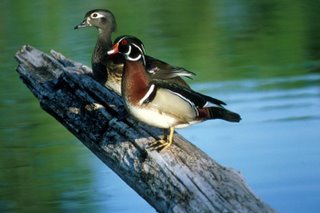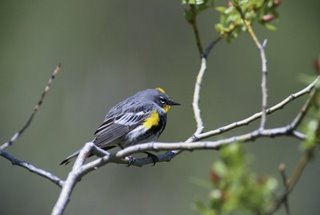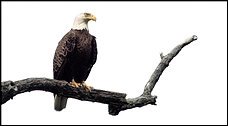This morning, the DC Audubon Society made a trip down to two sites in Prince William County, Virginia. The first, Cockpit Point Road, runs through power company land that is a mix of open fields and upland forest. The second, the Julie Metz Wetlands near Leesylvania State Park, consists of bottomland forest and marsh habitats. The combination of habitats at the two sites made for a good morning of birding.
We saw far too many birds today for me to talk about all of them, or even all of the highlights. Migration does appear to be picking up, even if the numbers of individuals are still somewhat low. The morning started off cool and overcast when we gathered at the intersection of Possum Point and Cockpit Point Roads, but by late morning the clouds burned off, and a blue sky appeared.
I had one life bird on this trip, a yellow-throated warbler. It was singing near the top of a pine tree along Cockpit Point Road. With some help, I got a look at it. The yellow-throated warbler's color pattern is somewhat similar to the yellow-rumped, except that it has a yellow throat, and no yellow rump or epaulettes. In the same area, there were a prairie warbler, field sparrow, both orchard and Baltimore orioles, and a summer tanager. The prairie warbler has one of my favorite songs in the warbler family.
Further down the road, we started finding more warblers. First, a worm-eating warbler sat right over the road and sang; one could not ask for a better view. Northern parulas and black-and-white warblers sang along the length of the road. A couple spots had black-throated greens singing, and in one spot we got a look at a male black-throated blue. Near the end of the road, there was a singing Louisiana waterthrush, but no one could locate it for a close look. And of course we had other songbirds - my first scarlet tanagers of the year, some singing indigo buntings, and plenty of singing wood thrushes and blue-gray gnatcatchers. In just a few days, red-eyed vireos have become ubiquitous.
On the drive back out towards Route 1, we added hooded warbler and yellow-breasted chat along the side of Possum Point Road. As far as I know, no one ever saw the hooded. But in response to some pishing, the chat flew out of the bushes and perched in the open. Chats have very distinctive calls, which combine a lot of odd sounds. They are even less musical than gray catbirds.
At Julie Metz, we added yellow-throated and warbling vireos, barn and tree swallows, and an American redstart. A short boardwalk trail led to great views of yellow warblers and common yellowthroats, two boldly-colored and unmistakable warblers. Though our group had dwindled down to four, a few of us went to look for a king rail, and were successful. Unfortunately we did not get to see it, but we did hear its call clearly and repeatedly.
I had never birded at either location before today, so I was not quite sure what to expect. After this morning's walks, I could see that these sites are very good even on average days, when there has not been much overnight movement. I can only imagine what these sites must be like after a heavy influx of migrants.
SPECIES SEEN: 84
Common Loon
Double-crested Cormorant
Great Blue Heron
Canada Goose
Mallard
Turkey Vulture
Osprey
Bald Eagle
Sharp-shinned Hawk
Red-shouldered Hawk
Red-tailed Hawk
King Rail
Killdeer
Greater Yellowlegs
Solitary Sandpiper
Spotted Sandpiper
Rock Pigeon
Mourning Dove
Chimney Swift
Ruby-throated Hummingbird
Belted Kingfisher
Red-bellied Woodpecker
Hairy Woodpecker
Pileated Woodpecker
Eastern Phoebe
Great Crested Flycatcher
Tree Swallow
Barn Swallow
Ruby-crowned Kinglet
Cedar Waxwing
Carolina Wren
Gray Catbird
Northern Mockingbird
Brown Thrasher
Eastern Bluebird
Wood Thrush
American Robin
Blue-gray Gnatcatcher
Carolina Chickadee
Tufted Titmouse
White-breasted Nuthatch
Blue Jay
American Crow
Fish Crow
European Starling
House Sparrow
White-eyed Vireo
Yellow-throated Vireo
Warbling Vireo
Red-eyed Vireo
Purple Finch
House Finch
American Goldfinch
Northern Parula
Yellow Warbler
Black-throated Blue Warbler
Yellow-rumped Warbler
Black-throated Green Warbler
Yellow-throated Warbler
Pine Warbler
Prairie Warbler
Palm Warbler
Black-and-white Warbler
American Redstart
Worm-eating Warbler
Ovenbird
Louisiana Waterthrush
Common Yellowthroat
Hooded Warbler
Yellow-breasted Chat
Scarlet Tanager
Summer Tanager
Eastern Towhee
Chipping Sparrow
Field Sparrow
Song Sparrow
White-throated Sparrow
Northern Cardinal
Indigo Bunting
Red-winged Blackbird
Common Grackle
Brown-headed Cowbird
Baltimore Oriole
Orchard Oriole



































